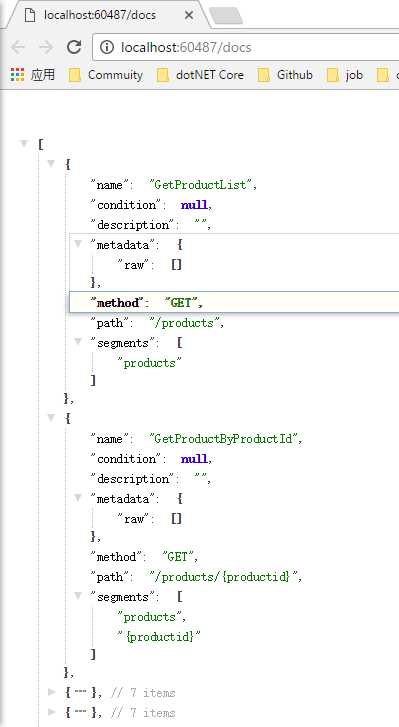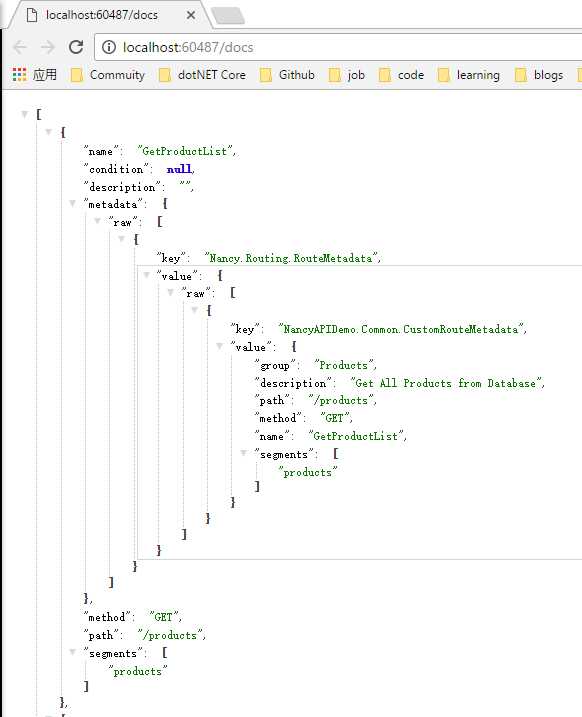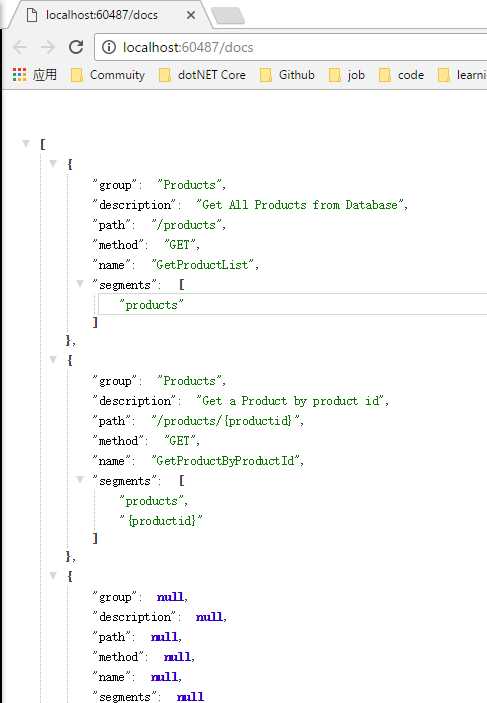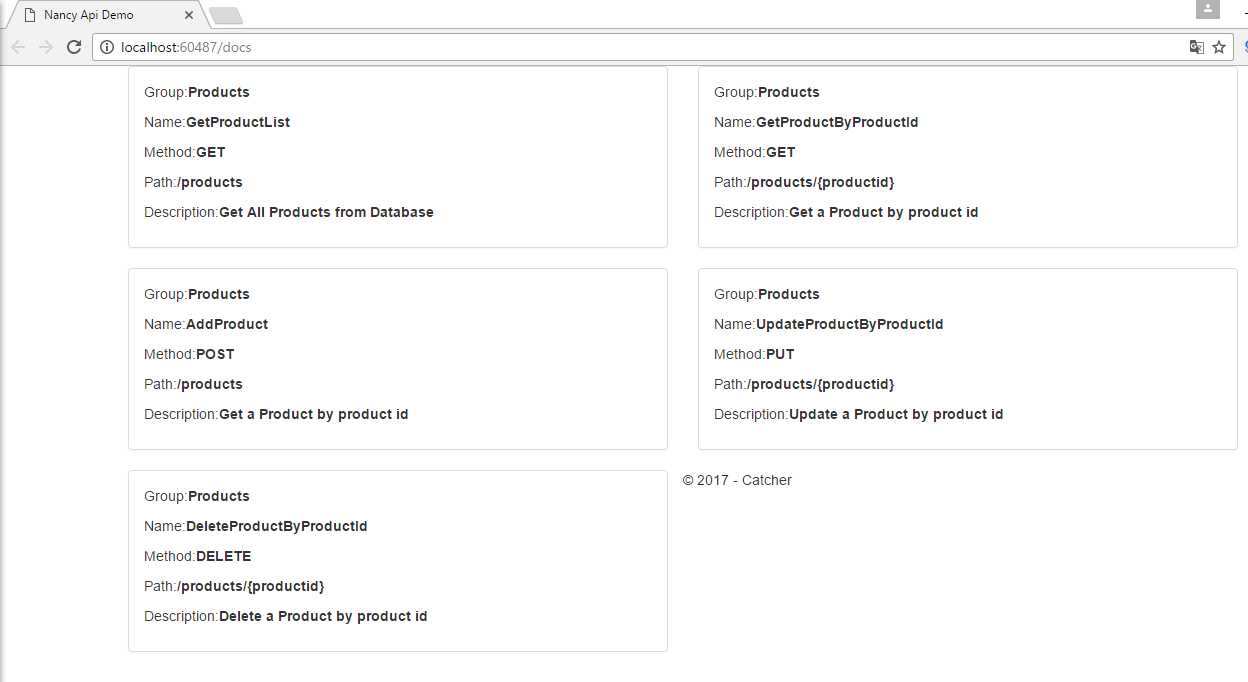标签:int hand pdf .com www. efault factory 意义 集合
原文:浅析如何在Nancy中生成API文档前后端分离,或许是现如今最为流行开发方式,包括UWP、Android和IOS这样的手机客户端都是需要调用后台的API来进行数据的交互。
但是这样对前端开发和APP开发就会面临这样一个问题:如何知道每个API做什么?
可能,有人会在内部形成一份word文档、pdf;有人会建立一个单独的站点,然后将API的地址,参数等信息列在上面;有人会借助第三方的工具来生成一份文档等。
当然,这基本是取决于不同公司的规范。
说起API文档,就想到前段时间做的微信小程序,由于那个不完善的接口文档,从而导致浪费了很大一部分时间去询问接口相关的内容(用的是老的接口)。
为了处理这个问题,我认为,如果能在写某个API的时候就顺带将这个API的相关信息一并处理了是最好不过!
不过这并不是让我们写好一个接口后,再去打开word等工具去编辑一下这个API的信息,这样明显需要花费更多的时间。
下面就针对这一问题,探讨一下在Nancy中的实现。
其实,想在Nancy中生成API文档,是一件十分容易的事,因为作者thecodejunkie已经帮我们在Nancy内部提前做了一些处理
便于我们的后续扩展,这点还是很贴心的。
下面我们先来写点东西,后面才能写相应的API文档。
public class ProductsModule : NancyModule
{
public ProductsModule() : base("/products")
{
Get("/", _ =>
{
return Response.AsText("product list");
}, null, "GetProductList");
Get("/{productid}", _ =>
{
return Response.AsText(_.productid as string);
}, null, "GetProductByProductId");
Post("/", _ =>
{
return Response.AsText("Add product");
}, null, "AddProduct");
//省略部分..
}
}基本的CURD,没有太多的必要去解释这些内容。当然这里需要指出一点。
正常情况下,我们基本都是只写前面两个参数的,后面两个参数是可选的。由于我们后面需要用到每个路由的名字
所以我们需要用到这里的第4个参数(当前路由的名字),也就意味着我们要在定义的时候写多一点东西!
注: 1.x和2.x的写法是有区别的!示例用的2.x的写法,所以各位要注意这点!
以GET为例,方法定义大致如下

API写好了,下面我们先来简单获取一下这些api的相关信息!
前面也提到,我们是要把这个api和api文档放到同一个站点下面,免去编辑这一步骤!
世间万物都是相辅相成的,我们不想单独编辑,自然就要在代码里面多做一些处理!
新起一个Module名为DocModule,将api文档的相关内容放到这个module中来处理。
public class DocMudule : NancyModule
{
private IRouteCacheProvider _routeCacheProvider;
public DocMudule(IRouteCacheProvider routeCacheProvider) : base("/docs")
{
this._routeCacheProvider = routeCacheProvider;
Get("/", _ =>
{
var routeDescriptionList = _routeCacheProvider
.GetCache()
.SelectMany(x => x.Value)
.Select(x => x.Item2)
.Where(x => !string.IsNullOrWhiteSpace(x.Name))
.ToList();
return Response.AsJson(routeDescriptionList);
});
}
}没错,你没看错,就是这几行代码,就可以帮助我们去生成我们想要的api文档!其实最主要的是IRouteCacheProvider这个接口。
它的具体实现,会在后面的小节讲到,现在先着重于使用!
先调用这个接口的GetCache方法,以拿到缓存的路由信息,这个路由信息有必要来看一下它的定义,因为不看它的定义,我们根本就没有办法继续下去!
后续的查找都是依赖于这些缓存信息!
public interface IRouteCache : IDictionary<Type, List<Tuple<int, RouteDescription>>>, ICollection<KeyValuePair<Type, List<Tuple<int, RouteDescription>>>>, IEnumerable<KeyValuePair<Type, List<Tuple<int, RouteDescription>>>>, IEnumerable
{
bool IsEmpty();
}看了上面的定义,就可以清楚的知道要用SelectMany去拿到那个元组的内容。再取出元组的RouteDescription。
当然,这个时候我们取到的是所有的路由信息,这些信息都包含了什么内容呢?看看RouteDescription的定义就很清晰了。
public sealed class RouteDescription
{
public RouteDescription(string name, string method, string path, Func<NancyContext, bool> condition);
//The name of the route
public string Name { get; set; }
//The condition that has to be fulfilled inorder for the route to be a valid match.
public Func<NancyContext, bool> Condition { get; }
//The description of what the route is for.
public string Description { get; set; }
//Gets or sets the metadata information for a route.
public RouteMetadata Metadata { get; set; }
//Gets the method of the route.
public string Method { get; }
//Gets the path that the route will be invoked for.
public string Path { get; }
//Gets or set the segments, for the route, that was returned by the Nancy.Routing.IRouteSegmentExtractor.
public IEnumerable<string> Segments { get; set; }
}在查询之后,我还过滤了那些名字为空的,不让它们显示出来。为什么不显示出来呢?理由也比较简单,像DocModule,我们只定义了一个路由
而且这个路由在严格意义上并不属于我们api的内容,而且这个路由也是没有定义名字的,所以显示出来的意义也不大。
过滤之后,就得到了最终想要的信息!简单起见,这里是先直接 返回一个json对象,便于查看有什么内容,便于在逐步完善后再把它结构化。
下面是最简单实现后的大致效果:

在图中,可以看到GetProductList和GetProductByProductId这两个api的基本信息:请求的method,请求的路径和路由片段。
但是这些信息真的是太少了!连api描述都见不到,拿出来,肯定被人狠狠的骂一顿!!
下面我们要尝试丰富一下我们的接口信息!
要让文档充实,总是需要一个切入点,找到切入点,事情就好办了。仔细观察上面的效果图会发现,里面的metadata是空的。当然这个也就是丰富文档内容的切入点了。
从前面的定义可以看到,这个metadata是一个RouteMetadata的实例
public class RouteMetadata
{
//Creates a new instance of the Nancy.Routing.RouteMetadata class.
public RouteMetadata(IDictionary<Type, object> metadata);
//Gets the raw metadata System.Collections.Generic.IDictionary`2.
public IDictionary<Type, object> Raw { get; }
//Gets a boolean that indicates if the specific type of metadata is stored.
public bool Has<TMetadata>();
//Retrieves metadata of the provided type.
public TMetadata Retrieve<TMetadata>();
}这里对我们比较重要的是Raw这个属性,因为这个是在返回结果中的一部分,它是一个字典,键是类型,值是这个类型对应的实例。
先定义一个CustomRouteMetadata,用于返回路由的Metadata信息(可根据具体情况进行相应的定义)。这个CustomRouteMetadata就是上述字典Type。
public class CustomRouteMetadata
{
// group by the module
public string Group { get; set; }
// description of the api
public string Description { get; set; }
// path of the api
public string Path { get; set; }
// http method of the api
public string Method { get; set; }
// name of the api
public string Name { get; set; }
// segments of the api
public IEnumerable<string> Segments { get; set; }
}定义好我们要显示的东西后,自然要把这些东西用起来,才能体现它们的价值。
要用起来还涉及到一个MetadataModule,这个命名很像NancyModule,看上去都是一个Module。
先定义一个ProductsMetadataModule,让它继承MetadataModule<RouteMetadata>,
具体实现如下:
public class ProductsMetadataModule : MetadataModule<RouteMetadata>
{
public ProductsMetadataModule()
{
Describe["GetProductList"] = desc =>
{
var dic = new Dictionary<System.Type, object>
{
{
typeof(CustomRouteMetadata),
new CustomRouteMetadata
{
Group = "Products",
Description = "Get All Products from Database",
Path = desc.Path,
Method = desc.Method,
Name = desc.Name,
Segments = desc.Segments
}
}
};
return new RouteMetadata(dic);
};
Describe["GetProductByProductId"] = desc =>
{
var dic = new Dictionary<System.Type, object>
{
{
typeof(CustomRouteMetadata),
new CustomRouteMetadata
{
Group = "Products",
Description = "Get a Product by product id",
Path = desc.Path,
Method = desc.Method,
Name = desc.Name,
Segments = desc.Segments
}
}
};
return new RouteMetadata(dic);
};
//省略部分...
}
}这里的写法就和1.x里写NancyModule的内容是一样的,应该也是比较熟悉的。就不再累赘了。其中的desc是一个委托Func<RouteDescription, TMetadata>。
默认返回的是一个RouteMetadata实例,而要创建一个这样的实例还需要一个字典,所以大家能看到上面的代码中定义了一个字典。
并且这个字典包含了我们自己定义的信息,其中Group和Description是完全的自定义,其他的是从RouteDescription中拿。
当然,这里已经开了一个口子,想怎么定义都是可以的!
完成上面的代码之后,再来看看我们显示的结果

可以看到我们添加的metadata相关的内容已经出来了!可能这个时候,大家也都发现了,似乎内容有那么点重复的意思!
因为这些重复,就会让人感觉这里比较臃肿,所以我们肯定不需要取出太多重复的东西,目前只需要metadata下面的这些就可以了。
下面来对其进行简化!
简化分为两步:
第一步简化:DocModule的简化。
其实,DocModule已经是相当的简单了,但是还能在简洁一点点。这里用到了RetrieveMetadata这个扩展方法来处理。
前面的做法是拿到路由的信息后,用了两个Select来查询,而且查询出来的结果有那么一点臃肿,
而借助扩展方法,可以只取metadata里面的内容,也就是前面自定义的内容,这才是我们真正意义上要用到的。
下面是具体实现的示例:
Get("/", _ =>
{
//01
//var routeDescriptionList = _routeCacheProvider
// .GetCache()
// .SelectMany(x => x.Value)
// .Select(x => x.Item2)
// .Where(x => !string.IsNullOrWhiteSpace(x.Name))
// .ToList();
//return Response.AsJson(routeDescriptionList);
//02
var routeDescriptionList = _routeCacheProvider
.GetCache()
.RetrieveMetadata<RouteMetadata>()
.Where(x => x != null);
return Response.AsJson(routeDescriptionList);
});经过第一步简化后,已经过滤了不少重复的信息了,效果如下:

第二步简化:Metadata的简化
在返回Metadata的时候,我们是返回了一个默认的RouteMetadata对象,这个对象相比自定义的CustomRouteMetadata复杂了不少
而且从上面经过第一步简化后的效果图也可以发现,只有value节点下面的内容才是api文档需要的内容。
所以还要考虑用自定义的这个CustomRouteMetadata去代替原来的。
修改如下:
public class ProductsMetadataModule : MetadataModule<CustomRouteMetadata>
{
public ProductsMetadataModule()
{
Describe["GetProductList"] = desc =>
{
return new CustomRouteMetadata
{
Group = "Products",
Description = "Get All Products from Database",
Path = desc.Path,
Method = desc.Method,
Name = desc.Name,
Segments = desc.Segments
};
};
Describe["GetProductByProductId"] = desc =>
{
return new CustomRouteMetadata
{
Group = "Products",
Description = "Get a Product by product id",
Path = desc.Path,
Method = desc.Method,
Name = desc.Name,
Segments = desc.Segments
};
};
//省略部分..
}
}由于MetadataModule<TMetadata> 中的TMetadata是自定义的CustomRouteMetadata,所以在返回的时候直接创建一个简单的实例即可
不需要像RouteMetadata那样还要定义一个字典。
同时,还要把DocModule中RetrieveMetadata的TMetadata也要替换成CustomRouteMetadata
var routeDescriptionList = _routeCacheProvider
.GetCache()
//.RetrieveMetadata<RouteMetadata>()
.RetrieveMetadata<CustomRouteMetadata>()
.Where(x => x != null);经过这两步的简化,现在得到的效果就是我们需要的结果了!

最后,当然要专业一点,不能让人只看json吧!怎么都要添加一个html页面,将这些信息展示出来:

当然,现在看上去还是很丑,文档内容也并不丰富,但是已经把最简单的文档做出来了,想要进一步丰富它就可以自由发挥了。
既然这样简单的代码就能帮助我们去生成api文档,很有必要去研究一下Nancy帮我们做了什么事!
从最开始的IRouteCacheProvider入手,这个接口对应的默认实现DefaultRouteCacheProvider
public class DefaultRouteCacheProvider : IRouteCacheProvider, IDiagnosticsProvider
{
/// <summary>
/// The route cache factory
/// </summary>
protected readonly Func<IRouteCache> RouteCacheFactory;
/// <summary>
/// Initializes a new instance of the DefaultRouteCacheProvider class.
/// </summary>
/// <param name="routeCacheFactory"></param>
public DefaultRouteCacheProvider(Func<IRouteCache> routeCacheFactory)
{
this.RouteCacheFactory = routeCacheFactory;
}
/// <summary>
/// Gets an instance of the route cache.
/// </summary>
/// <returns>An <see cref="IRouteCache"/> instance.</returns>
public IRouteCache GetCache()
{
return this.RouteCacheFactory();
}
//省略部分..
}里面的GetCache方法是直接调用了定义的委托变量。最终是到了IRouteCache的实现类RouteCache,这个类算是一个重点观察对象!
内容有点多,就只贴出部分核心代码了
它在构造函数里去生成了路由的相关信息。
public RouteCache(
INancyModuleCatalog moduleCatalog,
INancyContextFactory contextFactory,
IRouteSegmentExtractor routeSegmentExtractor,
IRouteDescriptionProvider routeDescriptionProvider,
ICultureService cultureService,
IEnumerable<IRouteMetadataProvider> routeMetadataProviders)
{
this.routeSegmentExtractor = routeSegmentExtractor;
this.routeDescriptionProvider = routeDescriptionProvider;
this.routeMetadataProviders = routeMetadataProviders;
var request = new Request("GET", "/", "http");
using (var context = contextFactory.Create(request))
{
this.BuildCache(moduleCatalog.GetAllModules(context));
}
}具体的生成方法如下:遍历所有的NancyModule,找到每个Module的RouteDescription集合(一个Module可以包含多个路由)
然后找到每个RouteDescription的描述,路由片段和metadata的信息。最后把这个Module路由信息添加到当前的对象中!
private void BuildCache(IEnumerable<INancyModule> modules)
{
foreach (var module in modules)
{
var moduleType = module.GetType();
var routes =
module.Routes.Select(r => r.Description).ToArray();
foreach (var routeDescription in routes)
{
routeDescription.Description = this.routeDescriptionProvider.GetDescription(module, routeDescription.Path);
routeDescription.Segments = this.routeSegmentExtractor.Extract(routeDescription.Path).ToArray();
routeDescription.Metadata = this.GetRouteMetadata(module, routeDescription);
}
this.AddRoutesToCache(routes, moduleType);
}
}前面提到RouteDescription的描述,路由片段和metadata的信息都是通过额外的方式拿到的,这里主要是拿metadata来做说明
毕竟在上面最后的一个例子中,用到的是metadata的内容。
先调用定义的私有方法GetRouteMetadata,这个方法里面的内容是不是和前面的MetadataModule有点类似呢,字典和创建RouteMetadata的实例。
private RouteMetadata GetRouteMetadata(INancyModule module, RouteDescription routeDescription)
{
var data = new Dictionary<Type, object>();
foreach (var provider in this.routeMetadataProviders)
{
var type = provider.GetMetadataType(module, routeDescription);
var metadata = provider.GetMetadata(module, routeDescription);
if (type != null && metadata != null)
{
data.Add(type, metadata);
}
}
return new RouteMetadata(data);
}重点的是provider。这个provider来源来IRouteMetadataProvider,这个接口就两个方法。
Nancy这个项目中还有一个抽象类是继承了这个接口的。但是这个抽象类是没有默认实现的。
public abstract class RouteMetadataProvider<TMetadata> : IRouteMetadataProvider
{
public Type GetMetadataType(INancyModule module, RouteDescription routeDescription)
{
return typeof(TMetadata);
}
public object GetMetadata(INancyModule module, RouteDescription routeDescription)
{
return this.GetRouteMetadata(module, routeDescription);
}
protected abstract TMetadata GetRouteMetadata(INancyModule module, RouteDescription routeDescription);
}注:前面的原理分析都是基于Nancy这个项目。
这个时候,另外一个项目Nancy.Metadata.Modules就起作用了。我们编写的MetadataModule也是要添加这个的引用才能正常使用的。
从上面编写的MetadataModule可以看出这个项目的起点应该是MetadataModule,而且有关metadata的核心也在这里了。
public abstract class MetadataModule<TMetadata> : IMetadataModule where TMetadata : class
{
private readonly IDictionary<string, Func<RouteDescription, TMetadata>> metadata;
protected MetadataModule()
{
this.metadata = new Dictionary<string, Func<RouteDescription, TMetadata>>();
}
// Gets <see cref="RouteMetadataBuilder"/> for describing routes.
public RouteMetadataBuilder Describe
{
get { return new RouteMetadataBuilder(this); }
}
// Returns metadata for the given RouteDescription.
public object GetMetadata(RouteDescription description)
{
if (this.metadata.ContainsKey(description.Name))
{
return this.metadata[description.Name].Invoke(description);
}
return null;
}
// Helper class for configuring a route metadata handler in a module.
public class RouteMetadataBuilder
{
private readonly MetadataModule<TMetadata> parentModule;
public RouteMetadataBuilder(MetadataModule<TMetadata> metadataModule)
{
this.parentModule = metadataModule;
}
// Describes metadata for a route with the specified name.
public Func<RouteDescription, TMetadata> this[string name]
{
set { this.AddRouteMetadata(name, value); }
}
protected void AddRouteMetadata(string name, Func<RouteDescription, TMetadata> value)
{
this.parentModule.metadata.Add(name, value);
}
}
//省略部分..
}到这里,已经将GetCache的内内外外都简单分析了一下。至于扩展方法RetrieveMetadata就不在细说了,只是selectmany和select的一层封装。
本文粗略讲解了如何在Nancy中生成API文档,以及简单分析了其内部的处理。

下一篇将继续介绍这一块的内容,不过主角是Swagger。
标签:int hand pdf .com www. efault factory 意义 集合
原文地址:https://www.cnblogs.com/lonelyxmas/p/9068177.html